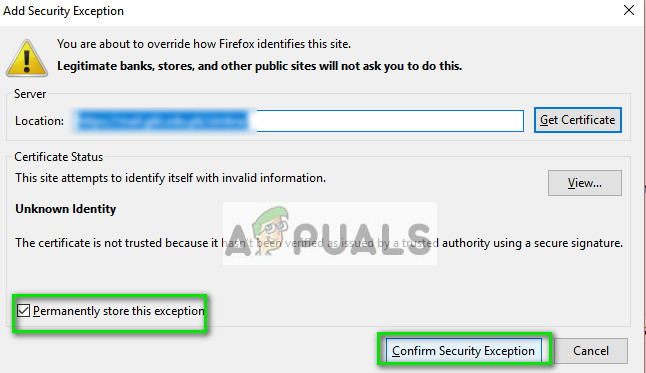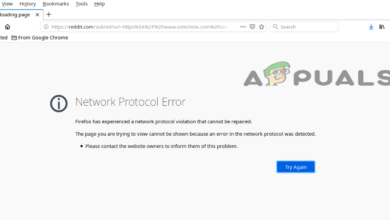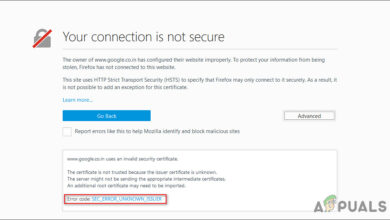Fix: Your Connection is not Secure Firefox
Whenever Firefox connects to a secure website, it verifies that the certificate presented by the website is valid and the encryption is strong enough to protect your privacy. If the certificate cannot be validated or the encryption is not strong enough, Firefox will not proceed with the browsing and display an error message instead.

Sometimes this Firefox error message can be legit and should of concern to you. However, if you are encountering this error on multiple popular websites such as Google, Facebook, Bing, etc; you can take a look at the workarounds listed and see if any work in your case.
But before moving on with the solutions, keep in mind that Firefox has a known bug to create this type of issue. For example, if you are visiting testsite.com/anypage then it will give this particular error. But if you firstly visit testsite.com and then open testsite.com/anypage, in that case, Firefox will operate normally. Make sure that is not the case with you. Also, if you are using a VPN, then either temporarily disable it or change the server for your VPN connection to check if that is the root cause of the issue. Moreover, you can use any other DNS server like Google DNS to check if your ISP’s DNS server is causing the problem.
Solution 1: Setting Correct Time and Date
If your computer’s time is not accurate, it will cause a discrepancy while checking and verifying several certificates and will cause Firefox to throw an exception and display the error message. You will most probably also be prompted on the error page after you click ‘advanced’. If you have set the time to be automatically set or if the time is incorrect, follow the steps listed and see if this solves the problem.
- Press Windows + R, type “control” in the dialogue box and press Enter.
- Once in the control panel, select “Date and Time” or “Clock and Region” according to the type of control panel selected.

Open Date and Time Settings - Once the clock is opened, click “Change date and time”. Now set the correct time and also select the correct region.

Change Date and Time - Press ‘Apply’ after implementing all the changes and check if you can successfully browse the website without any errors.
RELATED: Safari can’t establish a secure connection to the server
Solution 2: Disabling Antivirus Software
There are several antivirus software which provides an additional layer of security to your browser. This extra layer of security might sometimes conflict with the existing layers in the browser and thus cause the error message under discussion.
The detailed error message, in this case, is “SEC_ERROR_UNKNOWN_ISSUER”. You can probably resolve this issue by disabling SSL or browser scanning from your computer through your antivirus.
In this solution, you have to explore yourself and see if there are any settings in your antivirus which might be proving that extra layer. You are looking for anything which monitors your internet activity.
If you are unable to still fix the problem, you can disable the antivirus completely. You can check our article on How to Disable your Antivirus. Restart your computer after disabling and see if you can access the sites without any problem.
Solution 3: Changing ‘security.enterprise_roots.enabled’
There is a setting in Mozilla Firefox where the browser will trust certificates in the Windows certificate store shared by other browsers such as Explorer, Chrome, or Safari, etc. This helps in cases where you do not have complete access to your computer and some certificates are being impossible to import by Firefox on its own. We will change this setting and see if this fixes the problem.
- Open Firefox and type “about:config” in the address area and press Enter.
- Now when the search bar appears at the top of the window, type “root” in the dialogue box and wait for the results to be populated.
- Select the option “enterprise_roots.enabled”. Right-click it and select “Toggle”. This will enable the value which was first false.

Toggle the Value of enterprise_roots.enabled to True - Now try opening any web page and see if you can access without any problems. Do note that you might get a prompt about the warning associated with changing the preferences. Ignore the warning and continue the solution.
Solution 4: Disabling SSL3 Preferences
If the above methods don’t work out as expected, we can change the setting of SSL in the preferences and see if the problem gets solved. We will also tweak minor changes while carrying out the solution.
- Open Firefox and type “about:config” in the address area and press Enter.
- Now when the search bar appears at the top of the window, type “ssl3” in the dialogue box and now wait for the results to be populated.
- Change both values to “false” by toggling the key.

Toggle SSL3 Values to False - Now select the menu icon present at the top-right side of the window and click “Help” and then “Troubleshooting Information”.

Open Troubleshooting Information - Now under the heading “Application Basics”, click “Open folder” in front of Profile Folder.

Open Profile Folder - Now run the DataBase Files of “cert8.db” and “cert9.db” for them to be updated. You need to close Mozilla Firefox first before running the files.

Update cert8.db Files - Now open Firefox and check if you can access the websites without any problems.
Solution 5: Enabling “Auto-Detect Proxy” and Refreshing Mozilla
If all the above methods don’t work, we can try enabling the “auto-detect proxy server on this network”. You may be using a proxy server in some organization or through your ISP without you knowing. Enabling this option will automatically detect such a server and make changes to the configuration accordingly.
- Press the menu icon on the top-right side of the window. Now select “General” and click “Settings” under the heading of “Network Proxy”.

Open Network Proxy Settings - Now select the option “Auto-detect proxy settings for this network”. Save changes and exit.

Enable Auto-detect proxy settings for this network - Restart Mozilla Firefox and see if this fixes the problem.
If this doesn’t fix the issue, we can try resetting Firefox and see if this brings out about any change. Do note that all your existing settings and bookmarks will be deleted along with the history. Proceed after backing up everything.
- Navigate to troubleshooting information as shown in the earlier steps. Click “Refresh Firefox” present at the right-end.

Refresh Firefox - Restart your computer. Also make sure that there is no antivirus software running on your computer such as AVG, Kaspersky, etc. After disabling them, check again if the issue is fixed.
Method: Adding Exception for a Single Website
If you are only encountering this error for a single website, you can an exception despite the additional risks involved. Normally, this isn’t the course of action recommended but if you are well aware of the website’s infrastructure and know for certain that there are no risks involved, you can easily make an exception and access it like a regular website.
- Open the website you want to access which gives you the error message. Click Advanced and then select Add Exception.

Add Exception for a Website - A new dialogue box will pop up. Confirm Security Exception after clicking the action box and see if you can access the website without any problems.

Confirm Security Exception
In addition to the above solutions, you can also try:
- Update Windows and Firefox to the latest version available.
- Try accessing the website in Mozilla on other systems. You can also make sure that the problem lies with the website by checking it in other browsers.
- Use a new Firefox profile or try using in-private browsing.
- You may try using Private Mode of Firefox.
- Check the behavior after making a new administrator account.
- If the problem pertains only to computers present in your network, contact your ISP/Network administrator.
- If you are having problems accessing websites despite all the steps mentioned, you can always consider exporting your data and replacing Mozilla with other browsers out there.





